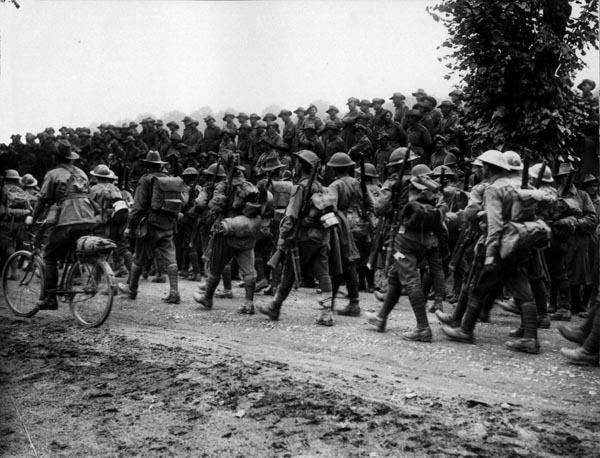The First World War was not a surprise. The events and forces that led to it had been festering for decades...
1914: The road to catastrophe
WORKERS, FEB 2012 ISSUE
When the First World War broke out on 4 August 1914, it did so against a background of intensifying conflicts and rivalries between the leading capitalist powers. Rival capitalisms were set on a gradual drift towards world conflagration as the differing interests and alliances locked market competitors into opposition and implacable hostility.
Probably the first impulse to general war can be traced back to the Prussian victory over France in 1870. The resulting unification and creation of the German Empire in 1871 led to a change in the balance of capitalist powers in Europe, with Germany now the strongest military might on the continent, possessing large and expanding industrial resources.
Germany annexed Alsace-Lorraine after 1870, throwing the French state into an alliance with Russia, splitting Europe into two opposing camps and opening up a period of competitive armament and a militaristic environment. Additionally, the war’s wake brought about the political re-grouping of Europe on the basis of Franco-German antagonism.

The Australian 6th Division marching to the Somme.
The period prior to the First World War was one of unprecedented economic rivalry and shifting economic strengths. Industrial developments in France, Belgium, Italy, Russia, India, Japan but above all in Germany and America, had put an end to the British capitalist monopoly of the world market that had held sway in the first half of the 19th century.
It was a dangerous mix of rising and declining capitalist powers, emerging and waning imperial forces, strutting the world looking for advantage. As now, the pursuit of profits by finance capital was the chief political dynamic, and the workings of capitalism itself led to war.
The nations of Europe were also competing in their colonial expansion. In the 1880s and 1890s the pace of imperialist competition increased, especially in Africa and the Far East. Those powers possessing no colonies, notably Italy and Germany, thought they should have some.
Colonies were profitable to finance capital. Britain secured control of Egypt and a powerful colonial empire in southern Africa; France took possession of Tunis in north Africa and Tonkin in east Asia; Italy secured a foothold in Abyssinia; Russia accomplished its conquests in central Asia, pushed into Manchuria and extended control across Siberia to the Pacific with the Trans-Siberian railway; Germany won its first colonies in Africa and in the South Seas; the USA procured the Philippines.
There was a chain of bloody wars and conquests in imperial expectation of economic gain and to safeguard frontiers or exclude rivals from vacant territory. All these colonial developments created new, extra-European antagonisms: between Italy and France in northern Africa, France and Britain in Egypt, Britain and Russia in central Asia, Russia and Japan in eastern Asia, Japan and Britain in China, and the USA and Japan in the Pacific Ocean.
Rivalries
Imperialist rivalries led to rapid growth of militarisation. By 1897, German military policies underwent radical change moving from Bismarck’s strategy of power on land across the continent to challenging for supremacy on the ocean as well. Germany attempted to rival Britain as the world’s greatest naval force, a feverish naval race began, with the building of dreadnoughts and battleships on both sides.
Imperial Britain, facing the rise of the new Imperial German High Seas Fleet, committed resources to staying ahead at sea. In 1904, Britain created a North Sea Fleet based at Rosyth on the east coast of Scotland to counter the threat from the large German navy.
Europe divided into rival alliance systems. Often begun as defensive manoeuvring, they became offensive structures escalating the scale of conflict and animosities. Between 1879 and 1902, the German–Austrian and Franco–Russian treaties were made, followed by the Triple Alliance of Germany, Austria and Italy, the England and France entente, the England and Russia entente, and then Britain allied with Japan. In 1914 alliances dragged nations into war.
Crises and flashpoints brought the world to the verge of a general conflict: Morocco, Macedonia, Bosnia, Agadir and Albania. But each time a greater clash was postponed, as the sides were not yet ready with military preparations, though the final conflict was already forming.
What might have been
The only force that might have prevented the world war – the working classes of the world, particularly Europe – did not do so. In 1907 and 1912 the Second International (of workers’ organisations) had declared: “Should war nevertheless break out, it shall be the duty of the social democracy to work for a speedy peace, and to strive with every means in its power to utilise the industrial and political crisis to accomplish the awakening of the people, thus hastening the overthrow of capitalist class rule.” But as the German Communist, Rosa Luxemburg, observed in 1915, “The first thunder of Krupp cannons in Belgium welded Germany into a wonderland of social harmony.”
Across Europe there was a working class retreat into “defence of nation, defence of empire”. International social democracy capitulated to capitalism’s whims and working men killed and destroyed each other in the ‘methodical, organised, gigantic murder’ of world war. The major social democratic parties of Germany, France and Britain rushed to the ‘defence of their fatherlands’ and in patriotic frenzy voted for war credits and clamoured about enemies.
It was left to Lenin and the Bolshevik Party in Russia in October 1917 to take workers out of an imperialist war and recognise its real aims – the seeking of territory and spheres of influence, trade advantage, raw materials, control of trade routes, and political, economic or military domination of vulnerable nations.
The inter-imperialist war happened brought the mass slaughter of an estimated 10 million people plus 20 million wounded. History warns. ■